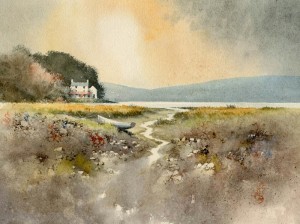Where I live we are blessed with countless streams and waterfalls tumbling down the hills and mountains, and I like nothing better than to wander beside a mountain stream with sketchbook, well away from the hurly-burly of life. One mountain stream is worth far more than a thousand mental health quacks for our well-being. In my short demonstration painting last week on the Shopkeeparty site I painted a mountain stream on a misty day, as seen below, and on Thursday 13th will be doing a much longer, more considered workshop on the site.
In the painting I aimed to lose much of the mountain and its detail in background mist, using the wet-in-wet technique, pulling out some of the colour on the left-hand buttresses with a damp brush to suggest light catching the boiler-plate slabs of rock. This was accentuated when the paper had dried by painting in the left-hand buttress which contrasts the softer-edged wet-in-wet approach used on the right-hand one. The central group of conifers was also painted wet-in-wet so that a real sense of distance was created when the dark-tones trees on the left were added. Notice on the cascade how the rocks are placed with hard edges at the tops and soft ones where the rocks rise out of the tumbling water.
Next Thursday at 3.30pm I will be running a 2 to 3- hour workshop on painting a waterfall with sunlight and autumn colours, and you are welcome to join me. I shall be showing you how to tackle many fascinating features:
- how to introduce striking light effects
- creating effective rock structures
- making the most of exciting autumn colours
- the magic of wet-in-wet passages
- how to capture the energy of falling water
- the importance of lost and found edges …..and so much more!
You will find further information at Workshop: Autumn Waterfall with David Bellamy (shopkeeparty.com)
I shall look forward to seeing you then.




